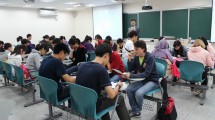Abstract
This study examined the efficacy and best practices in integrating a video-synchronous computer mediated communication tool “Talk Abroad” (TA) into an intermediate foreign language course. Students completed four TA projects, four immediate written reflections and an end-of-semester exit questionnaire. Quantitative analysis of students’ performance in the first and fourth conversations revealed that students have made significant increases in oral proficiency, especially in the area of accuracy and fluency. Qualitative analysis of learner written reflections demonstrated high affective gains despite different degrees in linguistic development. Through the pedagogical cycle of in-class instruction, TA practice, and immediate written reflections, students showed increasing autonomy in linguistic development and self-regulated learning strategies. All students reported that they were more engaged and willing to challenge themselves by the end of the study.
Access this chapter
Tax calculation will be finalised at checkout
Purchases are for personal use only
Similar content being viewed by others
Notes
- 1.
Student #4, Written Reflection 1. When quoting from students’ work, unless the source is clearly indicated in the body of the essay, students will be indicated by a number, followed by “WR” for “Written Reflection” plus a number indicating which of the students’ four reflections we are citing.
References
Belz, J. (2003). Linguistic perspectives on the development of intercultural competence in telecollaboration. Language, Learning and Technology, 7(2), 68–99.
DeKeyser, R. (2007). Skill acquisition theory. In B. VanPatten & J. Williams (Eds.), Theories in second language acquisition (pp. 97–113). Mahwah: Erlbaum.
Gardner, R. C. (1985). Social psychology and second language learning: The role of attitudes and motivation. London: Edward Arnold.
Gergen, K. J. (1999). An invitation to social construction. Thousand Oaks: Sage.
Hammadou Sullivan, J. (2011). Taking charge: Teacher candidates’ preparation for the oral proficiency interview. Foreign Language Annuals, 44(2), 241–257.
Hasko, V., Moser, R., Guida, F., Hayes, M., & Alves, V. (2017). Maximizing oral proficiency development via telecollaborative partnerships in the Portuguese flagship program. In D. Murphy & K. Evans-Romaine (Eds.), Exploring the US language flagship program: Professional competence in a second language by graduation (pp. 90–115). Tonawanda: Multilingual Matters.
Kato, F., Spring, R., & Mori, C. (2016). Mutually beneficial foreign language learning: Creating meaningful interactions through video-synchronous computer-mediated communication. Foreign Language Annuals, 49(2), 355–366.
Knell, E., & West, H. (2017). To delay or not to delay: The timing of Chinese character instruction for secondary learners. Foreign Language Annals, 50(3), 519–532.
Krashen, S. (1982). Principles and practice in second language acquisition. Oxford: Pergamon Press.
Lin, H. (2014). Establishing an empirical link between computer-mediated communication (CMC) and SLA: A meta-analysis of the research. Language, Learning and Technology, 18(3), 120–127.
Lin, H. (2015). Computer-mediated communication (CMC) in L2 oral proficiency development: A meta-analysis. ReCALL, 27(3), 261–287.
Moeller, A. J. (2013). Advanced low language proficiency: An achievable goal? Modern Language Journal, 97(2), 549–553.
Moreno-Lopez, I., Ramos-Sellman, A., Miranda-Aldaco, C., & Quinto, M. (2017). Transforming ways of enhancing foreign language acquisition in the Spanish classroom: Experiential learning approaches. Foreign Language Annuals, 50(2), 398–409.
Saito, K., & Akiyama, K. (2017). Video-based interaction, negotiation for comprehensibility, and second language speech learning: A longitudinal study. Language Learning, 67(1), 43–74.
Skehan, P. (1989). Individual differences in second language learning. London: Edward Arnold.
Sun, Z., Xie, K., & Anderman, L. (2017). The role of self-regulated learning in students’ success in flipped undergraduate math courses. The Internet and Higher Education, 36(January 2018), 41–53.
The American Council on the Teaching of Foreign Languages. (2015). ACTFL performance descriptors for language learners. Available at: https://www.actfl.org/publications/guidelines-and-manuals/actfl-performance-descriptors-language-learners. Accessed 27 Feb 2018.
Woo, Y., & Reeves, T. (2007). Meaningful interaction in web-based learning: A social constructivist interpretation. The Internet and Higher Education, 10, 15–25.
Author information
Authors and Affiliations
Corresponding author
Editor information
Editors and Affiliations
Rights and permissions
Copyright information
© 2019 Springer Nature Singapore Pte Ltd.
About this chapter
Cite this chapter
Sama, C.M., Wu, Y. (2019). Integrating “Talk Abroad” into an Intermediate Foreign Language Course: Building Learner Autonomy and Engagement Through Video Conversations with Native Speakers. In: Carrió-Pastor, M.L. (eds) Teaching Language and Teaching Literature in Virtual Environments. Springer, Singapore. https://doi.org/10.1007/978-981-13-1358-5_5
Download citation
DOI: https://doi.org/10.1007/978-981-13-1358-5_5
Published:
Publisher Name: Springer, Singapore
Print ISBN: 978-981-13-1357-8
Online ISBN: 978-981-13-1358-5
eBook Packages: Social SciencesSocial Sciences (R0)




